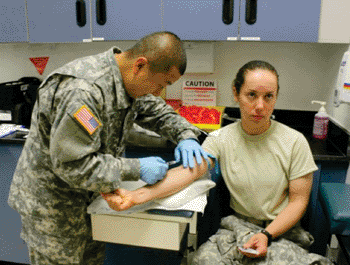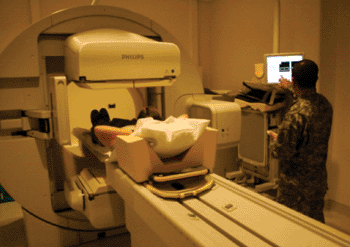US Army Hospital Physicians Create Way to Detect Stress Fractures Faster
|
By MedImaging International staff writers Posted on 03 Mar 2013 |

Image: Sgt. Christopher Funke, noncommissioned officer-in-charge of Nuclear Medicine at General Leonard Wood Army Community Hospital, injects Pfc. Sara Reagers, C Company, 84th Chemical Battalion, with a radiopharmaceutical agent (Photo courtesy of John Brooks).

Image: Three to four hours later after the substance has worked its way through the body, the single photon emission computed tomography (SPECT) system can detect the low-level radiation absorbed by stress-injured bone (Photo courtesy of John Brooks).

Image: Evaluating the scan (Photo courtesy of John Brooks).
A new imaging protocol developed by the US Army radiologists can now find stress fractures in soldiers much earlier than traditional X-rays.
Single photon emission computed tomography (SPECT) is typically used for nonmusculoskeletal imaging studies, such as cardiac, parathyroid, and adrenal gland imaging. But this ground breaking use of SPECT imaging, in conjunction with a low-dose computed tomography scan, allows General Leonard Wood Army Community Hospital (GLWACH; Lenard Wood, MO, USA) radiologists to optimally rank stress injuries for severity.
With this information, providers return about two thirds more Soldiers back to training after rehabilitation, long before injuries would normally progress to career-ending injuries and incurring large training losses. “SPECT-CT fusion forms a more anatomically-precise image to allow radiologists to pinpoint the exact location of a stress change,” explained Maj. Mustafa Ali-Khan, GLWACH radiology chief. “SPECT-CT is typically not employed in the manner it is here at Fort Leonard Wood. The use of SPECT fusion imaging, although not unique to Army medicine, is unique to its application in its dedicated capacity in musculoskeletal imaging at a Training and Doctrine Command facility, in the manner employed here at Fort Leonard Wood.”
This innovative imaging process was developed in 2010 by the GLWACH radiology department as the result of needs identified through the combined effort of GLWACH staff members in the Musculoskeletal Athletic Team, Orthopedics, Podiatry, and Combined Troop Medical Clinic. “After looking at our training population and our basic training missions, we realized that we could use this technology to our advantage,” Maj. Ali-Khan said.
The technology worked effectively and the numbers are incredible, according to Maj. Ali-Khan. GLWACH’s radiology department used their SPECT-CT fusion imaging technique about 300 times in 2011. “We expect to top 500 studies this year,” Maj. Ali-Khan said.
Typically, injured soldiers in training are given an X-ray and sent back to continue training if an injury is not visible. Missed stress injuries then progress and are discovered at a later date as a more serious insufficiency fracture, or stress fracture. “We have seen a dramatic increase in identification of early stress injuries here at GLWACH, which has led to better outcomes for our Soldier population and less patients who have progressed to more advanced stress injuries and [Medical Evaluation Board] cases,” Maj. Ali-Khan said. “Fewer patients end up with serious stress fractures due to the early intervention. SPECT-CT fusion imaging has worked well in the training environment to mitigate the overall number of bad outcomes with respect to evolving stress injuries. We have every reason to believe that other installations with SPECT equipment, as well as other branches of the military with high training populations subject to bone stress injuries could use our SPECT-CT fusion imaging protocol with a high success rate as well.”
Dr. Ali-Khan reported that the GLWACH medical department activity is fortunate to have this technology, which is typically only available at the Medical Center level at facilities such as Madigan Army Medical Center at Joint Base Lewis-McChord (WA, USA), Walter Reed National Military Medical Center (Bethesda, MD, USA), or Brooke Army Medical Center (San Antonio, TX, USA). “We all feel great to be a part of something so big at such a comparatively small facility,” he said.
It is hard to determine how many training losses will be prevented at GLWACH with SPECT-CT fusion imaging this year, according to Dr. Ali-Khan said. “But we can determine how many stress injuries the technology allows radiologists to catch, and then treat early,” he concluded.
Related Links:
General Leonard Wood Army Community Hospital
Single photon emission computed tomography (SPECT) is typically used for nonmusculoskeletal imaging studies, such as cardiac, parathyroid, and adrenal gland imaging. But this ground breaking use of SPECT imaging, in conjunction with a low-dose computed tomography scan, allows General Leonard Wood Army Community Hospital (GLWACH; Lenard Wood, MO, USA) radiologists to optimally rank stress injuries for severity.
With this information, providers return about two thirds more Soldiers back to training after rehabilitation, long before injuries would normally progress to career-ending injuries and incurring large training losses. “SPECT-CT fusion forms a more anatomically-precise image to allow radiologists to pinpoint the exact location of a stress change,” explained Maj. Mustafa Ali-Khan, GLWACH radiology chief. “SPECT-CT is typically not employed in the manner it is here at Fort Leonard Wood. The use of SPECT fusion imaging, although not unique to Army medicine, is unique to its application in its dedicated capacity in musculoskeletal imaging at a Training and Doctrine Command facility, in the manner employed here at Fort Leonard Wood.”
This innovative imaging process was developed in 2010 by the GLWACH radiology department as the result of needs identified through the combined effort of GLWACH staff members in the Musculoskeletal Athletic Team, Orthopedics, Podiatry, and Combined Troop Medical Clinic. “After looking at our training population and our basic training missions, we realized that we could use this technology to our advantage,” Maj. Ali-Khan said.
The technology worked effectively and the numbers are incredible, according to Maj. Ali-Khan. GLWACH’s radiology department used their SPECT-CT fusion imaging technique about 300 times in 2011. “We expect to top 500 studies this year,” Maj. Ali-Khan said.
Typically, injured soldiers in training are given an X-ray and sent back to continue training if an injury is not visible. Missed stress injuries then progress and are discovered at a later date as a more serious insufficiency fracture, or stress fracture. “We have seen a dramatic increase in identification of early stress injuries here at GLWACH, which has led to better outcomes for our Soldier population and less patients who have progressed to more advanced stress injuries and [Medical Evaluation Board] cases,” Maj. Ali-Khan said. “Fewer patients end up with serious stress fractures due to the early intervention. SPECT-CT fusion imaging has worked well in the training environment to mitigate the overall number of bad outcomes with respect to evolving stress injuries. We have every reason to believe that other installations with SPECT equipment, as well as other branches of the military with high training populations subject to bone stress injuries could use our SPECT-CT fusion imaging protocol with a high success rate as well.”
Dr. Ali-Khan reported that the GLWACH medical department activity is fortunate to have this technology, which is typically only available at the Medical Center level at facilities such as Madigan Army Medical Center at Joint Base Lewis-McChord (WA, USA), Walter Reed National Military Medical Center (Bethesda, MD, USA), or Brooke Army Medical Center (San Antonio, TX, USA). “We all feel great to be a part of something so big at such a comparatively small facility,” he said.
It is hard to determine how many training losses will be prevented at GLWACH with SPECT-CT fusion imaging this year, according to Dr. Ali-Khan said. “But we can determine how many stress injuries the technology allows radiologists to catch, and then treat early,” he concluded.
Related Links:
General Leonard Wood Army Community Hospital
Latest MRI News
- AI Tool Tracks Effectiveness of Multiple Sclerosis Treatments Using Brain MRI Scans
- Ultra-Powerful MRI Scans Enable Life-Changing Surgery in Treatment-Resistant Epileptic Patients
- AI-Powered MRI Technology Improves Parkinson’s Diagnoses
- Biparametric MRI Combined with AI Enhances Detection of Clinically Significant Prostate Cancer
- First-Of-Its-Kind AI-Driven Brain Imaging Platform to Better Guide Stroke Treatment Options
- New Model Improves Comparison of MRIs Taken at Different Institutions
- Groundbreaking New Scanner Sees 'Previously Undetectable' Cancer Spread
- First-Of-Its-Kind Tool Analyzes MRI Scans to Measure Brain Aging
- AI-Enhanced MRI Images Make Cancerous Breast Tissue Glow
- AI Model Automatically Segments MRI Images
- New Research Supports Routine Brain MRI Screening in Asymptomatic Late-Stage Breast Cancer Patients
- Revolutionary Portable Device Performs Rapid MRI-Based Stroke Imaging at Patient's Bedside
- AI Predicts After-Effects of Brain Tumor Surgery from MRI Scans
- MRI-First Strategy for Prostate Cancer Detection Proven Safe
- First-Of-Its-Kind 10' x 48' Mobile MRI Scanner Transforms User and Patient Experience
- New Model Makes MRI More Accurate and Reliable
Channels
Radiography
view channel
World's Largest Class Single Crystal Diamond Radiation Detector Opens New Possibilities for Diagnostic Imaging
Diamonds possess ideal physical properties for radiation detection, such as exceptional thermal and chemical stability along with a quick response time. Made of carbon with an atomic number of six, diamonds... Read more
AI-Powered Imaging Technique Shows Promise in Evaluating Patients for PCI
Percutaneous coronary intervention (PCI), also known as coronary angioplasty, is a minimally invasive procedure where small metal tubes called stents are inserted into partially blocked coronary arteries... Read moreUltrasound
view channel.jpeg)
AI-Powered Lung Ultrasound Outperforms Human Experts in Tuberculosis Diagnosis
Despite global declines in tuberculosis (TB) rates in previous years, the incidence of TB rose by 4.6% from 2020 to 2023. Early screening and rapid diagnosis are essential elements of the World Health... Read more
AI Identifies Heart Valve Disease from Common Imaging Test
Tricuspid regurgitation is a condition where the heart's tricuspid valve does not close completely during contraction, leading to backward blood flow, which can result in heart failure. A new artificial... Read moreNuclear Medicine
view channel
Novel Radiolabeled Antibody Improves Diagnosis and Treatment of Solid Tumors
Interleukin-13 receptor α-2 (IL13Rα2) is a cell surface receptor commonly found in solid tumors such as glioblastoma, melanoma, and breast cancer. It is minimally expressed in normal tissues, making it... Read more
Novel PET Imaging Approach Offers Never-Before-Seen View of Neuroinflammation
COX-2, an enzyme that plays a key role in brain inflammation, can be significantly upregulated by inflammatory stimuli and neuroexcitation. Researchers suggest that COX-2 density in the brain could serve... Read moreGeneral/Advanced Imaging
view channel
AI-Powered Imaging System Improves Lung Cancer Diagnosis
Given the need to detect lung cancer at earlier stages, there is an increasing need for a definitive diagnostic pathway for patients with suspicious pulmonary nodules. However, obtaining tissue samples... Read more
AI Model Significantly Enhances Low-Dose CT Capabilities
Lung cancer remains one of the most challenging diseases, making early diagnosis vital for effective treatment. Fortunately, advancements in artificial intelligence (AI) are revolutionizing lung cancer... Read moreImaging IT
view channel
New Google Cloud Medical Imaging Suite Makes Imaging Healthcare Data More Accessible
Medical imaging is a critical tool used to diagnose patients, and there are billions of medical images scanned globally each year. Imaging data accounts for about 90% of all healthcare data1 and, until... Read more
Global AI in Medical Diagnostics Market to Be Driven by Demand for Image Recognition in Radiology
The global artificial intelligence (AI) in medical diagnostics market is expanding with early disease detection being one of its key applications and image recognition becoming a compelling consumer proposition... Read moreIndustry News
view channel
GE HealthCare and NVIDIA Collaboration to Reimagine Diagnostic Imaging
GE HealthCare (Chicago, IL, USA) has entered into a collaboration with NVIDIA (Santa Clara, CA, USA), expanding the existing relationship between the two companies to focus on pioneering innovation in... Read more
Patient-Specific 3D-Printed Phantoms Transform CT Imaging
New research has highlighted how anatomically precise, patient-specific 3D-printed phantoms are proving to be scalable, cost-effective, and efficient tools in the development of new CT scan algorithms... Read more
Siemens and Sectra Collaborate on Enhancing Radiology Workflows
Siemens Healthineers (Forchheim, Germany) and Sectra (Linköping, Sweden) have entered into a collaboration aimed at enhancing radiologists' diagnostic capabilities and, in turn, improving patient care... Read more










 Guided Devices.jpg)










